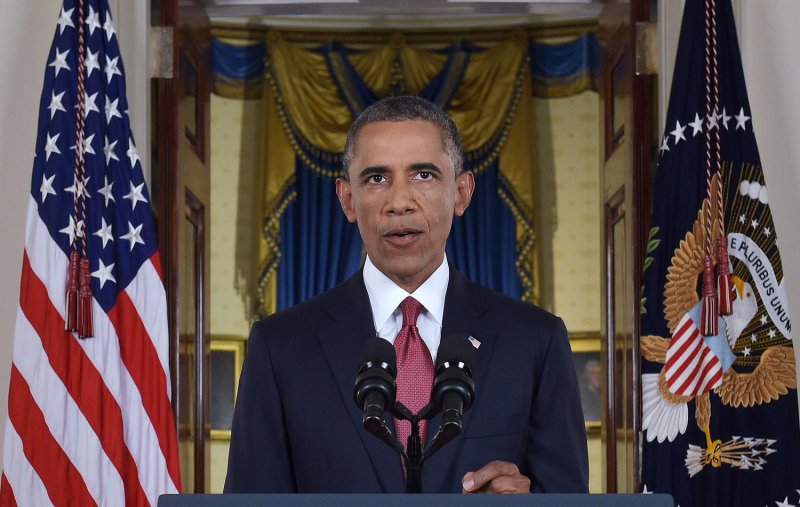US President Barack delivers a prime time address from the Cross Hall of the White House on September 10, 2014 in Washington, DC. Vowing to target the Islamic State with air strikes "wherever they exist", Obama pledged to lead a broad coalition to fight IS and work with "partner forces" on the ground in Syria and Iraq. UPI/Saul Loeb/Pool |
License Photo
WASHINGTON, Sept. 11 (UPI) -- IS isn't just targeting the Middle East and the US. It's aiming at Southeast Asia, too. Malaysian authorities recently stopped a major IS-influenced attack, and Indonesian and Philippine officials are scrambling to prevent their own growing flocks of IS-inspired terrorists from going on the rampage. IS is a global threat.
The Philippines' Foreign Ministry says that 200 of its citizens have gone to war under IS's flag in the Middle East. Most of these are orphans of dead fighters from domestic Islamist insurgent groups such as the Abu Sayyaf Group (ASG) and Moro National Liberation Front. Retired General Rodolfo Mendoza, head of the Institute for Peace, Violence and Terrorism Research, says, "They answer to no one and consider themselves one with the Islamic caliphate."
The ASG and the Bangsamoro Islamic Freedom Fighters (BIFF) announced their allegiance with IS in August. Other Philippine groups such as the Khilafah Islamiyah Movement (KIM), responsible for shopping center and hotel bombings, are inspired by IS and crave a caliphate.
Indonesia, long troubled by radicals that have fought for a caliphate for decades, recently banned its citizens from joining IS. Jailed terrorist kingpin Abu Bakar Ba'asyir, who heads Jemmah Anshorut Tauhid (JAT), reportedly pledged allegiance to IS in July. On August 9th, Indonesia's police counter terror unit, Detachment 88, arrested JAT official Afif Abdul Majid and two others for joining IS. Majid has helped carry out scores of operations in Indonesia, including suicide bombings against a church and a mosque in 2011. "We have found the [IS] flag on every terrorist arrested this year," Indonesian Police spokesman Boy Rafli Amar recently said.
At least 56 Indonesians have joined the IS fight in the Middle East.
Malaysian Special Branch (SB) arrested 19 IS-inspired suspects between April and June. Their mission was to attack civilian targets and overthrow Putrajaya, the "Washington DC of Malaysia," and replace it with a caliphate. Ayub Khan, head of SB's Counter Terror Division, says the targets included "...a disco, pubs in Kuala Lumpur and a Carlsberg [beer] factory." The accused included everyday professionals and two housewives. They had raised thousands of dollars for their plot and purchased aluminum powder, a common ingredient of homemade bombs. Mr. Khan said, "In terms of ideology and intention, it was very clear. It would have been carried out."
Malaysia says at least 20 of its citizens -- and probably more -- have joined IS in the Middle East, and at least three have been killed. One was a suicide bomber who died in Iraq in May.
What's it all mean?
First, IS's growing influence across Southeast Asia indicates trouble for the region. Malaysia will remain under threat, and IS-inspired fighters will worsen the low intensity conflicts in Indonesia and the Philippines. By default, this puts ever-vigilant Singapore at risk, which is always in the crosshairs of Islamist jihadists. IS might also inspire Thailand's otherwise local Islamist-Pattani nationalist insurgency that has increased violence in the face of failing negotiations with the government. According to the rebel manual, Fight for the Liberation of Pattani, they want a local caliphate, too. Burma's small Muslim vs. Buddhist conflict has already spilled over into Indonesia and Malaysia with a few bombings and assassinations. It's a candidate for IS provocation as well.
Second, IS's actions in Malaysia prove that it's not necessarily about concrete terror networks. Senate Majority Leader Harry Reid said recently IS couldn't attack the US at the moment, saying, "ISIS, they have no tentacles here yet." He's wrong. IS is primarily about inspiring individuals -- even housewives -- through its victories and successful Islamist jihadi "brand" that set up a large caliphate. Terrorist networking -- intelligence, planning, and logistics -- simply follows after these radicals coagulate.
Third, IS's activities in Southeast Asia indicate what it might do in America. Congressman Mike Rogers, Chairman of the House Intelligence Committee, says hundreds of Americans are fighting for IS in the Middle East, in part funneled there by a long standing "twin city" terror pipeline in Minneapolis-Saint Paul. The motivation of Islamist jihadists to attack America is here, IS has capitalized on it, and there are people to carry out these threats, just like Southeast Asia.
Ultimately, not countering IS "out there" before they "get here" has been a colossal strategic miscalculation by the Obama administration. "It is a threat to the United States," says Secretary of Defense Hagel. "...A clear threat to our partners in that area, and it is imminent." President Obama decisively defining the threat and what to do about is what America needs. Instead, it was British PM David Cameron who, on August 29th, gave a rousing, leadership-drenched speech declaring that it was IS's Islamist jihadi ideology that was the main threat to the UK. He then listed decisive steps to thwart it. In stark contrast, President Obama, even in his September 10th speech announcing strikes against IS in Iraq, continued to dance around this subject, pretending Islamist jihadi ideology is not an issue. It is a continuation of the Ostrich doctrine, which serves to protect no one.
Jeff Moore, Ph.D., is the chief executive officer of Muir Analytics, which assesses threats from insurgent and terror groups against corporations. He is the author of the recently published book, The Thai Way of Counterinsurgency.















